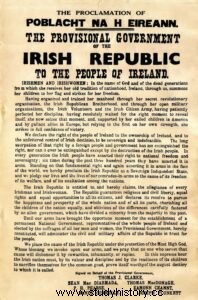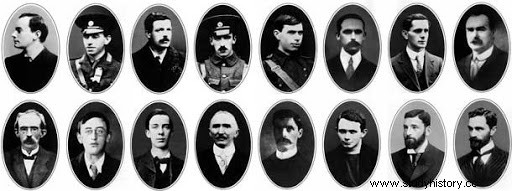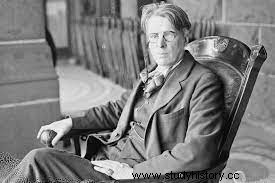Historical background:The Easter Rising in 1916
On Easter Sunday, men and women went to fight for an independent Ireland. The battle raged for six days and resulted in the destruction of many parts of Dublin city. The bloody executions of British leaders after the uprising aroused a generation to the cause of Irish freedom.
- Kostick Conor &Collins, Lorcan "The Easter Rising:A Guide to Dublin".
-
-

The Easter Rising in 1916 was considered a prelude to the independence of Ireland, finally achieved in 1921. The uprising took place in Dublin city, although it was supposed to have developed throughout the country. Most of the British soldiers fought in the First World War (1914 - 1918) at that time. Therefore, with the war as an advantage, the Irish Republican Brotherhood (IRB) decided to plan a redress.
On April 24, insurgents in the IRB joined forces with Irish volunteers and the Irish National Army in some strategic buildings in Dublin. One of these buildings was the General Post Office. There, Patrick Pearse, one of the leaders of the uprising, declared Ireland's independence and set up a provisional government. British soldiers did not expect the uprising, and they had several losses - around 234 approximately -.
However, the rebels did not have all the support needed to meet the British forces:on the one hand, Irish rebels expected a shipment of weapons and ammunition from Germany, but the British soldiers intercepted the ship and the cargo never arrived. On the other hand, they did not have the support of the Irish people themselves.
Consequences
As a result, the climb failed after six days of fighting:Dublin city center was virtually destroyed, along with more than 2,000 people killed or injured. When the uprising was over, the British government arrested the rebels and executed the main leaders of the resurrection:
- Éamonn Ceannt,
- Thomas James Clarke
- James connolly
-
- Thomas MacDonagh
- Patrick Pearse
- Joseph Mary Plunkett
- Seán MacDiarmada,
- Roger Casement
- Con Colbert
- Edward Daly
- Seán Heuston
- John MacBride,
- Michael Mallin
- Michael O'Hanrahan
- William Pearse
Despite the failure, however, this victim was not meaningless at all. The executed leaders became martyrs and these events encouraged the Irish people to gain independence:two years later, Sinn Féin - an independent political party - formed an Irish parliament in 1918 after the British general election.
At the same time, the Irish Republican Army (IRA) declared war on the British in 1919, ending in 1921. As a result, they signed the Anglo-Irish Treaty, which established Ireland as a free state (excluding Northern Ireland). Ireland was finally proclaimed an independent country on April 18, 1949.
William Butler Yeats:Easter, 1916
William Butler Yeats was an Irish poet born in Dublin on June 13, 1865. In the 1880s, Yeats met writers such as Lionel Johnson, Oscar Wilde and George Bernard Shaw. He also met Maud Gonne, a revolutionary woman who was a supporter of Irish independence. Yeats fell in love with her and she became the mouse for his poetry:he dedicated Countess Kathleen to her, among others. Similarly, he met John O'Leary, an Irish patriot who was banished for revolutionary nationalist activities. He instilled in Yeats the need to show Irish affairs in his literary work so that it became a source of inspiration for him.
In 1922 he became senator of the new Republic of Ireland, and in 1923 he won the Nobel Prize in Literature. He also founded the Irish Academy of Letters in 1932.
Yeats provided new avenues for English poetry movement, introductory themes and a poetic language that would leave its influence through the 20th century. He would continue to write poetry until the end of his life with an intensity and quality that surprised the critics. He eventually died on January 28, 1939 in Menton, France
Easter 1916 is a political poem in which Yeats depicts all his conflicting and complex feelings about the events of 1916. It was published in 1921, in the collection Michael Robartes and the Dancer.
Summary
Easter 1916 (click on the link to read the poem) is divided into three main parts. The first part corresponds to lines 1 - 16, the second part on lines 17 - 40, and the third part in lines 41 - 80.
First part
In the first stanza, Yeats moves us to his city, Dublin. There he describes meeting some friends and exchanging some "polite meaningless words" with them (lines 6 and 8). He also entertains them with "a mocking tale or a prank" (line 10).
However, the poem changes significantly when Yeats criticizes his country:"to be sure that they had and I / but lived where the motley is worn" (lines 13 and 14). He concludes the first stanza with the key verse that will be repeated throughout the poem:"Everything changed, changed completely / a terrible beauty is born" (lines 15 and 16).
Second part
In the second stanza, Yeats indirectly mentions some of the rebels' insurgents. For example, there is a clear reference to one of the most important leaders of the uprising, the teacher Patrick Pearse:"This man had kept a school / and rode our winged horse" (lines 24 and 25). He also refers to John MacBride. In fact, since MacBride was married to the woman Yeats had always loved, Maud Gonne, he talks about him with some rancor:
This other man I'd dreamed of
A drunk, dizzying lye
He had done the bitterest thing wrong
For someone who is close to my heart
Yet I number him in the song;
He too has resigned
In the informal comedy;
He too has been changed in turn
(Lines 31 - 37)
Third Party
To conclude, in the third stanza, Yeats encourages and praises the actions performed by his friends. He constantly uses natural elements such as rock, horse, birds, clouds or stream:
Hearts with one purpose alone
Through the summer and winter seems
Enchanted by a rock
To torment the living stream
(Lines 41 - 44)
However, Yeats also wonders if the victim was actually worthy or not:"was it, after all, unnecessary death?" (line 67). He describes how the main characters died as a result of fighting for their dreams, and refers to them, but this time using their names:
We know their dream; enough
Knowing that they dreamed and are dead;
And what about excess love
Confused them to the dead?
I write it in a verse -
MacDonagh and MacBride
And Connolly and Pearse
(Lines 69–75)
Language:theme, tone, mood and images
The theme is the main idea or meaning of a poem. Easter 1916 is a political poem about sacrifice, change, admiration and immortality. The author aims to commemorate the admirable sacrifice that the rebels made for Irish freedom in 1916. Although most of them died, they and their actions will be remembered forever and passed down through generations, and be immortal to Irish people.
The tone is the poet's attitude to the audience, while mood is the poem's general feeling. At Easter 1916, Yeats speaks to the audience, and he shows his feelings about the conflict. He had very conflicting feelings about the increase and all the events associated with Ireland:although he was a supporter of independence, he despised violence. The poem reflects his fascination and shock at the heroism that his countrymen showed, many of them his friends. He mixes personal considerations for the coexistence of Dublin with the executed leaders. Finally, Yeats reflects on the validity and significance of the victim.
The imaging technique consists of using certain words to create visual representations in our minds. For example, when Yeats describes his meeting with some friends:"to please a companion / around the fire in the bar" (lines 11-12). Another example full of images is:
The horse coming from the road,
The rider, the birds that span
From cloud to tumbling cloud
Minute by minute they change;
A shadow of a cloud on the creek
Changing minute by minute;
A horse-hoof slides on the brim,
And a horse splashes in it;
(Lines 45 - 52)
Literary units
Authors use literary means to convey deeper meanings through improved techniques that make the text more beautiful or even more mysterious, depending on the author's purpose. These techniques consist of different symbolisms and figurative meanings:metaphors, parables, metonymy, paradoxes, etc.
symbolism
- Line 25 - "and ride our winged horse":that horse symbolizes Pegasus, a mythological creature from ancient Greece.
- Line 43 - "enchanted to a stone / To torment the living stream":the stone stands for the people who died in the ascent. Yeats establishes a connection between them with a stone as a way to symbolize that they can not move.
Metaphors
Metaphors can be defined as a way of emphasizing the similarities of a thing by using a word or phrase that means something different.
Example:"no, no, no, not night, but death" (line 66).
The poet uses the word night, but instead he actually refers to death.
similar
Equations are comparisons of two different things to show certain similarities between them.
Example:"mumbling names of names / as a mother calls her child" (lines 61-62)
Yeats makes up for the fact that mumbling names like mothers do with their children by naming the names of the victims of the rising.
metonymy
Metonymy is the use of the name of a thing for it to another to which it is an attribute or to which it is attached.
Example:"but lived where the speckle is worn" (line 14)
Yeats pretends to be 'playing' with the normal association of clown clothes in some way. By using it, he gets the audience to associate it with his criticism of Ireland as a "stupid" country.
Example 2:"anywhere green is worn" (line 78)
Yeats associates the color green with Ireland.
Paradox
A paradox is a sentence that seems contradictory, but at the same time has a certain truth in it.
For example, the clearest paradox is when Yeats uses "a terrible beauty is born", which is the chorus of the poem.
Beauty stands for the positive things, like the admiration of the heroes' sacrifice. On the other hand, the horror that Yeats felt towards war and violence is terrible.
Synekdoke
Synecdoche consists of using a part of something to refer to a whole, or the opposite.
Example:"one-purpose hearts alone" (line 41).
The heart of this verse is a symbol that represents all the Irish people who were driven by a single purpose:freedom.
the conclusion
Easter 1916 is without a doubt one of the best political poems of the 20th century in English literary history. Ultimately, with this poem, Yeats, on the one hand, wanted to immortalize the heroic sacrifice of the leaders of the uprising. And on the other hand, he also wanted to emphasize the idea that, as the poem says, everyone has changed, changed completely. As Patrick Pearse said:
“You can not conquer Ireland; you can not extinguish the Irish passion for freedom. If our deed has not been sufficient to win freedom, our children will win it with a better deed. ”
References
books:
- Cruise O'Brien, Conor &Cruise O'Brien, Maire. "Ireland, a Brief History" Jordan, Carmel. "A Terrible Beauty:The Easter Rebellion and Yeat's Great Wall Tapestry." Bucknell University Press, 1987.
- Kendall, Tim. "The Oxford Handbook of British and Irish War Poetry". Chapter 12:'Easter, 1916:Yeats' First World War Poem' by Majorie Perloff. Oxford University Press, 2007
- Kostick, Conor &Collins, Lorcan. "Easter Rises:A Guide to Dublin in 1916". Osprey, 2000.
- Medina Casado, Carmelo. "Poetas Ingleses del Siglo XX". Editorial Synthesis, 2014.
- Smith, Stan. "Irish Poetry and the Construction of Modern Identity". Dublin:Irish Academic Press, 2005
Internet sources:
- http://www.biography.com
- http://www.nobelprize.org
- http://www.taoiseach.gov
- http://literary-devices.com/
- http://www.csun.edu
- http://www.easter1916.net





